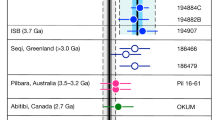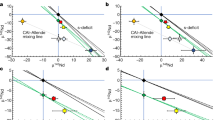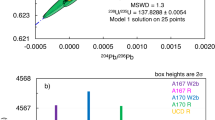Abstract
The 176Lu to 176Hf decay series has been widely used to understand the nature of Earth's early crust–mantle system1,2,3,4,5,6. The interpretation, however, of Lu–Hf isotope data requires accurate knowledge of the radioactive decay constant of 176Lu (), as well as bulk-Earth reference parameters. A recent calibration of the value calls for the presence of highly unradiogenic hafnium in terrestrial zircons with ages greater than 3.9 Gyr, implying widespread continental crust extraction from an isotopically enriched mantle source more than 4.3 Gyr ago7, but does not provide evidence for a complementary depleted mantle reservoir. Here we report Lu–Hf isotope measurements of different Solar System objects including chondrites and basaltic eucrites. The chondrites define a Lu–Hf isochron with an initial 176Hf/177Hf ratio of 0.279628 ± 0.000047, corresponding to = 1.983 ± 0.033 × 10-11 yr-1 using an age of 4.56 Gyr for the chondrite-forming event. This value indicates that Earth's oldest minerals were derived from melts of a mantle source with a time-integrated history of depletion rather than enrichment7. The depletion event must have occurred no later than 320 Myr after planetary accretion, consistent with timing inferred from extinct radionuclides8,9,10.
This is a preview of subscription content, access via your institution
Access options
Subscribe to this journal
Receive 51 print issues and online access
$199.00 per year
only $3.90 per issue
Buy this article
- Purchase on Springer Link
- Instant access to full article PDF
Prices may be subject to local taxes which are calculated during checkout


Similar content being viewed by others
References
Stevenson, R. K. & Patchett, P. J. Implications for the evolution of continental-crust from Hf-isotope systematics of Archean detrital zircons. Geochim. Cosmochim. Acta 54, 1683–1697 (1990)
Vervoort, J. D., Patchett, P. J., Gehrels, G. E. & Nutman, A. P. Constraints on early Earth differentiation from hafnium and neodymium isotopes. Nature 379, 624–627 (1996)
Vervoort, J. D. & Blichert-Toft, J. Evolution of the depleted mantle: Hf isotope evidence from juvenile rocks through time. Geochim. Cosmochim. Acta 63, 533–556 (1999)
Albarède, F., Blichert-Toft, J., Vervoort, J. D., Gleason, J. G. & Rosing, M. Hf–Nd evidence for a transient dynamic regime in early terrestrial mantle. Nature 404, 488–490 (2000)
Amelin, Y., Lee, D.-C., Halliday, A. N. & Pidgeon, R. T. Nature of the Earth's earliest crust from hafnium isotopes in single detrital zircons. Nature 399, 252–255 (1999)
Amelin, Y., Lee, D.-C. & Halliday, A. N. Early-middle Archaean crustal evolution deduced from Lu-Hf and U-Pb isotopic studies of single grain zircons. Geochim. Cosmochim. Acta 64, 4205–4225 (2000)
Scherer, E., Münker, C. & Mezger, K. Calibrating the Lu-Hf clock. Science 293, 683–686 (2001)
Harper, C. L. Jr & Jacobsen, S. B. Evidence from coupled 147Sm–143Nd and 146Sm–142Nd systematics for very early (4.5-Gyr) differentiation of the Earth's mantle. Nature 360, 728–732 (1992)
Boyet, M., Albarède, F., Télouk, P. & Rosing, M. 142Nd anomaly confirmed at Isua. Geochim. Cosmochim. Acta 66, Abst. A99 (2002)
Caro, G., Bourdon, B., Birck, J.-L. & Moorbath, S. 142Nd/144Nd precise determination in early Archean rocks. Geochim. Cosmochim. Acta 66, Abst. A120 (2002)
Yin, Q. et al. A short timescale for terrestrial planet formation from Hf–W chronometry of meteorites. Nature 418, 949–952 (2002)
Kleine, T., Münker, C., Mezger, K. & Palme, H. Rapid accretion and early core formation on asteroids and the terrestrial planets from Hf–W chronometry. Nature 418, 952–956 (2002)
Amelin, Y., Krot, A. N., Hutcheon, I. D. & Ulyanov, A. A. Lead isotopic ages of chondrules and calcium-aluminium-rich inclusions. Science 297, 1678–1683 (2002)
Dalmasso, J., Barci-Funel, G. & Ardisson, G. J. Reinvestigation of the decay of the long-lived odd-odd 176Lu nucleus. Appl. Radiat. Isot. 43, 69–76 (1992)
Nir-el, Y. & Lavi, N. Measurement of the half-life of 176Lu. Appl. Radiat. Isot. 49, 1653–1655 (1998)
Chase, C. G. & Patchett, P. J. Stored mafic/ultramafic crust and early Archean mantle depletion. Earth Planet. Sci. Lett. 91, 66–72 (1988)
Bennett, V. C., Nutman, A. P. & McCulloch, M. T. Nd isotopic evidence for transient, highly depleted mantle reservoirs in the early history of the Earth. Earth Planet. Sci. Lett. 119, 299–317 (1993)
Patchett, P. J. & Tatsumoto, M. Lu–Hf total-rock isochron for the eucrite meteorites. Nature 288, 571–574 (1980)
Tatsumoto, M., Unruh, D. M. & Patchett, P. J. U-Pb and Lu-Hf systematics of Antarctic meteorites. Proc. 6th Symp. on Antarctic meteorites: Mem. Nat. Inst. Polar Res. (Tokyo) Spec. Iss. 20, 237–249 (1981)
Blichert-Toft, J. & Albarède, F. The Lu-Hf isotope geochemistry of chondrites and the evolution of the mantle-crust system. Earth Planet. Sci. Lett. 148, 243–258 (1997)
Alexander, C. M. O'D., Boss, A. P. & Carlson, R. W. The early evolution of the inner solar system: A meteoritic perspective. Science 293, 64–68 (2001)
Lugmair, G. W. & Shukolyukov, A. Early solar system timescales according to 53Mn-53Cr systematics. Geochim. Cosmochim. Acta 62, 2863–2886 (1998)
Lugmair, G. W. Sm-Nd ages: a new dating method. Meteoritics 9, 369 (1974)
Lugmair, G. W. & Scheinin, N. B. Sm-Nd systematics of the Stannern meteorite. Meteoritics 10, 447–448 (1975)
Jacobsen, S. B. & Wasserburg, G. J. Sm-Nd isotopic evolution of chondrites. Earth Planet. Sci. Lett. 50, 139–155 (1980)
Göpel, C., Manhès, G. & Allègre, C. U-Pb systematics from equilibrated ordinary chondrites. Earth Planet. Sci. Lett. 121, 153–171 (1994)
Blichert-Toft, J., Boyet, M., Télouk, P. & Albarède, F. 147Sm-143Nd and 176Lu-176Hf in eucrites and the differentiation of the HED parent body. Earth Planet. Sci. Lett. 204, 167–181 (2002)
Dixon, D., McNair, A. & Curran, S. C. The natural radioactivity of lutetium. Phil. Mag. 45, 683–694 (1954)
Barfod, G. H. A New Lu-Hf Separation Technique for Phosphates and its Application to Apatite Geochronology. Thesis, Univ. Copenhagen (2002)
Bizzarro, M., Simonetti, A., Stevenson, R. K. & David, J. Hf isotope evidence for a hidden mantle reservoir. Geology 30, 771–774 (2002)
Blichert-Toft, J. & Arndt, N. T. Hf isotope compositions of komatiites. Earth Planet. Sci. Lett. 171, 439–451 (1999)
Acknowledgements
We thank F. Albarède and H. C. Larsen for comments on an earlier version of the manuscript, J. Blichert-Toft for access to unpublished data, Y. Amelin for discussion, and T. Waight for help in the Danish Lithosphere Centre MC-ICP-MS laboratory. This project was supported by the Danish Lithosphere Centre (funded by the Danish National Science Foundation). M.B. was supported by an NSERC postdoctoral fellowship.
Author information
Authors and Affiliations
Corresponding author
Ethics declarations
Competing interests
The authors declare that they have no competing financial interests.
Supplementary information
Rights and permissions
About this article
Cite this article
Bizzarro, M., Baker, J., Haack, H. et al. Early history of Earth's crust–mantle system inferred from hafnium isotopes in chondrites. Nature 421, 931–933 (2003). https://doi.org/10.1038/nature01421
Received:
Accepted:
Issue Date:
DOI: https://doi.org/10.1038/nature01421
This article is cited by
-
Half-life of the nuclear cosmochronometer 176Lu measured with a windowless 4π solid angle scintillation detector
Communications Physics (2023)
-
Magma Ocean, Water, and the Early Atmosphere of Venus
Space Science Reviews (2023)
-
Yangshan A-Type Granites in the Lower Yangtze River Belt Formed by Ridge Subduction: Radiogenic Ca and Nd Isotopic Constraints
Journal of Earth Science (2022)
-
Late Cretaceous eclogite in the Eastern Rhodopes (Bulgaria): evidence for subduction under the Sredna Gora magmatic arc
International Journal of Earth Sciences (2018)
-
Dating the initiation of Piemonte-Liguria Ocean subduction: Lu–Hf garnet chronometry of eclogites from the Theodul Glacier Unit (Zermatt-Saas zone, Switzerland)
Swiss Journal of Geosciences (2015)
Comments
By submitting a comment you agree to abide by our Terms and Community Guidelines. If you find something abusive or that does not comply with our terms or guidelines please flag it as inappropriate.



